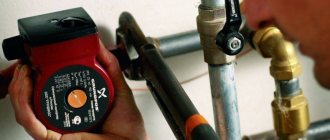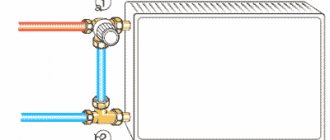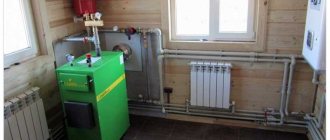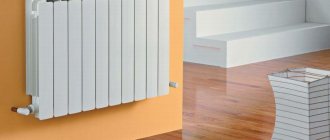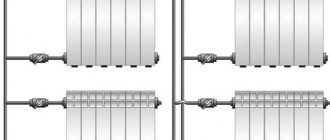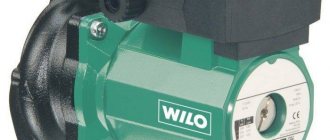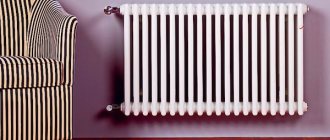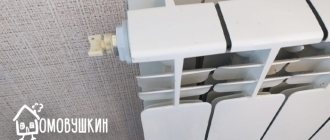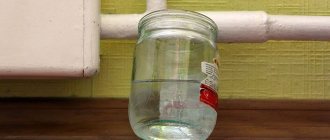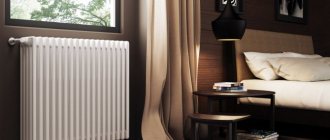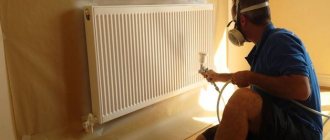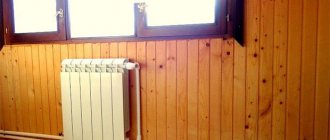With the beginning of the heating season, thousands of apartment owners have the same question: the battery in the apartment does not heat, what to do? Despite the fact that the neighboring ones are hot. It would seem that since everyone is working, then this one should heat up, but this does not happen. This also puzzles owners of country houses and summer cottages with heating. The system was recently installed, and the batteries are partially not warming up. There may be several reasons for this. Let's look at them below.
Despite the fact that the operating principle of the heating system is basically the same, there are some differences, without knowledge of which it is difficult to understand the cause of a non-functioning battery.
Causes of cold radiators
If, with the onset of cold weather and the heating season, heating is provided to your home, but the radiators do not work, then the problem may be a technical malfunction or the functioning of the entire supply system.
Especially if we are talking about a city apartment, the provision of heat in which should be handled by the housing and communal services service or another authorized body that checks the preparedness of the entire system for the heating season. Well, in the case of a private house, solving problems falls on your shoulders. If you wish, you can contact the Eurolux Group company; this company will carry out all the work quickly and inexpensively.
And here it is important to understand the main causes and individual problems that will need to be eliminated in order for the batteries to give off the maximum amount of heat
The main factors that cause batteries to remain cold can be identified:
- presence of air pockets in the heating system;
- technical blockage of a single battery;
- incorrect connection of each of the elements and the entire system as a whole.
These criteria can affect the performance of both the individual battery and the overall system. Only after these problems have been eliminated will it be possible to talk about the full functional operation of the heating system in each room.
Let's consider each reason separately.
Air jams
When studying the functional features and eliminating the problems of cold radiators and batteries, it is important to take care not only of one of them, but also to check the condition of the entire system. This type of solution requires testing for operability if there are air pockets in the system
Traffic jams can occur due to the appearance of excess air during radiator operation. At the same time, if we are talking about a city house, then, as a rule, the upper floors of high-rise buildings suffer.
But this problem can be easily fixed. To do this, in modern batteries special valves are installed in the upper part, which allow the accumulated air to be removed, restoring the operation of the system.
Heating system clogged
If heating has already been turned on in the system, and you still have cold radiators, there is a possibility that the existing system elements are clogged. This can be either the deposition of the corrosive properties of the metal or the gradual accumulation of scale and large amounts of dirt on the walls of radiators.
To perform flushing efficiently and quickly, follow these recommendations:
- move furniture aside, remove curtains, cover the floor with cellophane or cloth to avoid damage;
- shut off the coolant supply using the shut-off valve. If it is not installed, remove the battery, unscrew it and pour the liquid into a basin;
- to clean the radiator, it must be moved to a bathtub, at the bottom of which it is recommended to place a wooden floor;
- Using a wrench, unscrew the end caps and allow the dirty liquid to flow out of the battery into the bath;
- pour water under pressure from a hose into the battery;
- If a crystalline blockage has formed, it should be cleaned using a special reagent. Through the use of a chemical formula and high-quality pressure in the system, it is possible to remove existing problem areas of scale and corrosion and obtain warm and fully functioning batteries again. You can also use a 70% solution of vinegar and water;
- pour the reagent or vinegar solution into the battery, close the seals and let it brew for 2 hours;
- Rinse the battery inside and outside under high pressure water, wipe the battery dry and install it on the bracket.
Sometimes such actions do not help and you have to buy a new battery.
Connection errors
Also, a separate point may be such a reason as incorrect connection of each element of the heating system. Sometimes the supply pipes with the coolant and the supplied liquid are fixed from below.
This does not allow the battery to gain maximum heat, and the upper areas may remain cold. In this case, it is necessary to reinstall the connection elements and release heat through the upper section of the supply pipes and connections.
Adviсe
So, if you find that the radiators in the apartment have become cold or not warm enough, we recommend doing the following:
- Determine the type of possible breakdown. If this is a separate battery, then it is necessary to shut off the flow of coolant into this element. This can be done using a supply valve.
- Wait for the liquid to cool and disconnect the damaged, non-functional battery.
- Clean the system or install a new battery.
- Allow coolant to flow in and check the operation of the entire system.
Today, important parameters when choosing radiators and radiators are heat transfer and efficiency. Thoughtful solutions using the quality characteristics of metal make it possible to obtain not only durable, but also more practical elements for heating an apartment or room.
That's why many people strive to replace old cast iron batteries and install modern and more economical ones. In addition, the aesthetic appearance of the batteries is not the least important. Today there is a choice of batteries that are ideal for the interior, creating comfort and coziness in the room.
Pressure, water speed and return temperature in the heating system
Basically, the requirements for heating systems imply dividing the specifics of heating into two types:
- independent, here the source of heat energy is located directly in the room - used in an individual house or in multi-storey buildings of an elite type;
- dependent, where a network of pipelines is connected to the heating complex - used in most houses in the urban area and urban-type settlements.
Due to the specific nature of the circulation of the coolant, water is predominantly used, where the speed of water in the heating system directly affects the temperature in the radiators. Circulation is divided into natural (based on the principle of gravity) and forced (heating system using a pump). According to distribution, it is customary to distinguish between a heating system with lower and upper pipe distribution.
Temperature
Despite the wide selection of heating systems provided, the options for heat supply and return are quite limited. The maximum temperature in the heating system must also be set according to the rules in order to avoid further malfunctions.
Radiators are connected to the heating system in one of three ways: bottom, side or diagonal.
Also, the lower connection is also called differently: “Leningradka”, saddle. According to this scheme, the return and supply are installed at the bottom of the battery. In most cases, it is used when pipes are laid under the baseboard or under the floor surface. The return temperature in the heating system should not differ from the supply temperature.
Water speed
If there are few sections, heat transfer will be extremely ineffective compared to other schemes - the speed of water in the heating system decreases, which leads to heat loss.
Side heating is the most popular type of connecting radiator batteries to heating. The supply of water as a heat carrier is carried out in the upper part, and the return is connected from below, so that the return temperature in the heating system is considered equal.
To avoid a decrease in the efficiency of this type of connection when increasing the radiator sections, it is recommended to install an injection tube.
Pressure
The diagonal type of connection is also called a side cross circuit, because the water supply is connected at the top of the radiator, and the return is organized at the bottom of the opposite side. It is advisable to use it when connecting a significant number of sections - with a small number, the pressure in the heating system increases sharply, which can lead to undesirable results, that is, heat transfer can be halved.
To finally settle on one of the options for connecting radiator batteries, you must be guided by the methodology for organizing the return flow. It can be of the following types: single-pipe, double-pipe and hybrid.
The option you should choose will directly depend on a combination of factors. It is necessary to take into account the number of floors of the building, where the heating is connected, the requirements for the price equivalent of the heating system, what type of circulation is used in the coolant, the parameters of the radiator batteries, their dimensions and much more.
Most often, their choice is made on a single-pipe heating pipe layout.
As practice shows, such a scheme is used precisely in modern high-rise buildings.
Such a system has a number of characteristics: they are low in cost, fairly easy to install, and the coolant (hot water) is supplied from above when choosing a vertical heating system.
Also, radiators are connected to the heating system in series type, and this, in turn, does not require a separate riser for organizing the return. In other words, water, having passed the first radiator, flows into the next, then into the third, and so on.
However, there is no way to regulate the uniform heating of radiator batteries and its intensity; high coolant pressure is constantly recorded in them. The further the radiator is installed from the boiler, the more heat transfer decreases.
There is also another wiring method - a 2-pipe scheme, that is, a heating system with return. It is most often used in luxury housing or in individual homes.
Here is a pair of closed circuits, one of them is intended for supplying water to parallel-connected batteries, and the second is for draining it.
Hybrid wiring combines the two schemes described above. This could be a collector circuit, where an individual wiring branch is organized at each level.
Consequences of cold return
Circuit for heating return
Sometimes, with an incorrectly designed design, the return flow in the heating system is cold. As practice shows, the fact that the room does not receive enough heat with a cold return is half the trouble. The fact is that at different supply and return temperatures, condensation may form on the walls of the boiler, which, when interacting with carbon dioxide released during fuel combustion, forms acid. It can also damage the boiler much ahead of time.
To avoid this, it is necessary to carefully consider the design of the heating system, special attention must be paid to such a nuance as the return temperature. Or include additional devices in the system, for example, a circulation pump or boiler, which will compensate for the loss of warm water
Radiator connection options
Now we can more than confidently say that when designing a heating system, the supply and return must be perfectly thought out and configured. If the design is incorrect, more than 50% of the heat can be lost
There are three options for inserting a radiator into the heating system:
- Diagonal.
- Lateral.
- Bottom.
The diagonal system gives the highest efficiency coefficient, and is therefore more practical and efficient.
The diagram shows a diagonal inset
How to regulate the temperature in the heating system?
In order to regulate the temperature of the radiator and reduce the difference between the supply and return temperatures, you can use a heating system temperature controller.
When installing this device, do not forget about the jumper, which must be located in front of the heating device. If it is absent, you will regulate the temperature of the batteries not only in your room, but throughout the riser. It is unlikely that the neighbors will be happy with such actions.
The simplest and cheapest option for a regulator is to install three valves: on the supply, on the return and on the jumper. If you cover the valves on the radiator, the jumper must be open.
There is a huge abundance of different thermostats that can be used in apartment and private buildings. Among the wide variety, each consumer can choose a regulator that will suit him in terms of physical parameters and, of course, cost.
Safety valve in the heating system
Why is half the battery cold?
When the radiator is not connected correctly.
The main reason why the battery is half cold may be that it is connected incorrectly. According to the rules for installing heating equipment in a heating circuit, the pipe supplying hot coolant must be connected to the top of the battery. The cold pipe or return, on the contrary, is to its lower part. Also read: “Radiator brackets.”
How can we explain this?
You need to take into account the laws of physics and remember that hot water is much lighter than cold water, and therefore is located in the upper part of the heating device. Gradually releasing its thermal energy to the surrounding air, the coolant cools down. Its density, and hence its weight, increases. He goes down. That is why often half of the battery is cold and half is hot.
In any case, if the radiator is half cold, you need to seek help from a specialist rather than try to solve the problem yourself. This can lead to equipment damage or injury.
Low coolant temperature.
The heating device was installed correctly, but still half of the battery is cold. What to do in this case? Very often, especially in frosty weather outside, the coolant enters the heating circuit at an insufficiently high temperature. Giving up heat to the heating element, it cools down completely. This is why the effect of a cold radiator from below is created.
Contamination inside the heating device.
Debris, rust, as a result of corrosion of the inside of the heating circuit, can lead to the fact that the batteries are half cold. What to do in such a situation? Before the start of the heating season, especially if the thermal distribution was organized several decades ago, it is necessary to clean the radiators. To do this, a locksmith from the relevant service is called and he performs all the work.
Things are worse if the radiators do not heat up after the start of the heating season. In this case, the riser of an apartment building or the heating circuit of a private building is completely taken out of service. After all, it is possible to remove contaminants from the radiator only when there is no coolant in it.
Air jams.
They may be the reason why half of the battery is cold. It is easy to check their presence if the supply pipe and return pipe of the heating element are equipped with ball valves or thermostats. They are simply blocked. Then the upper tap is opened while the lower one remains closed for only 10-15 seconds. If extraneous sounds and gurgling are heard when the coolant enters, there is air inside the heating element. It prevents the free circulation of hot water, so half of the battery does not heat.
The problem can be solved by simply bleeding the air. For this purpose, heating devices are equipped with a Mayevsky tap or an ordinary tap in the upper part. A container for collecting hot water is first installed under the locking mechanism. The Mayevsky tap opens and remains in this position until all the air leaves the heating device. The process is accompanied by spraying hot water under pressure. That is why it is recommended to cover the tap with a cloth.
The cross-section of the supply pipe is narrowed.
The heating element is installed correctly, it is new and there is no air inside, and the battery is half cold. Reason: a thermostat or tap with a narrowed flow area is installed. What does it mean? Through a pipe with a narrowed cross-section, half the coolant enters the radiator. As a result, the speed of water movement in the radiator decreases, and therefore the temperature of its surface decreases.
What needs to be done?
Dismantle the taps in front of the heating element. Before choosing a new device, be sure to consult a specialist. He must calculate the required cross-section of the valve, which will not affect the movement of coolant in the circuit.
Full room heating
The air temperature in the room will always be low if half of the radiator is cold, half is hot. The reason for this may be improper installation of the radiator, the presence of a tap in front of it with a narrowed cross-section, dirt and air inside the heating element. Any problem can be resolved if you seek help from a specialist. It is not recommended to carry out repairs yourself, as this can lead to equipment failure or injury.
>
Let's deflate
In cases where the riser corresponds to the thermal regime, but the battery does not, then the residents themselves remove the accumulation of air, for which they use a Mayevsky tap on the batteries.
Before opening the valve, you must first turn off the heat supply and place rags under the radiator, because dirty water will come out along with the air. The tap is opened using a screwdriver, which is inserted into a special recess.
When the accumulated air is released from the hole, it will come out with a certain sound. After the air leaves the battery, dirty water should appear from the hole. After this, the tap can be closed. After this procedure, heat supply is restored in full.
Please note! The tap is installed on each heating device, but you should not be zealous, so a similar procedure is carried out only with those devices that are cold
Please note that the tap may have to be opened more than once
This procedure becomes more difficult if the air accumulation is not in indoor radiators, but in pipes located in the basement. You carry out the procedure described above, and the batteries are cold, then you should call a plumber from the management company, who will open the valve and release the air, which prevents heat from flowing through the batteries.
How to eliminate uneven heat transfer
Not all problems can be solved on your own. Poor heat transfer from the radiator may be a consequence of non-compliance with the slopes, indicating gross violations in the installation of the heating system. In this case, you will have to invite a specialist in heating systems.
Some heating problems can be fixed on your own.
Air locks - air in the heating system is an inevitable consequence of filling pipes and radiators with coolant. A characteristic sign of the problem is that the radiator is warm at the bottom and cold at the top. If the section heats up unevenly, you can try to bleed air from the system using the Mayevsky valve. Some owners initially install an automatic air release valve.
Air jams
The most common cause of heating problems is air locks, which are formed due to a leak, rapid filling of the system, or as a result of heating the water. They appear especially often in apartments on the upper floors.
p, blockquote 6,0,0,0,0 –>
To make cold radiators hot, you need to remove air from the system. Modern models are equipped with special exhaust valves located at the top of the batteries and operating in automatic mode. Also, a Mayevsky valve or drain valve can be installed on the radiators, with the help of which air is removed manually.
The Mayevsky valve is a cone-shaped rod with a thread, when unscrewed, a through hole opens and the gaseous medium is removed from the coolant.
p, blockquote 8,0,0,0,0 –>
p, blockquote 9,0,0,0,0 –>
What to do if they are absent? If heating is turned on, but the radiators remain cold, you should contact the management company or the housing office and call a plumber to remove air from the system. Typically, a preventive check is carried out after supplying coolant to the system to prevent uneven heating.
p, blockquote 10,1,0,0,0 –>
Heating system clogged
The last battery is too long.
Why is one battery hot and the other cold? Experts cite the following reasons for this situation:
- airing of the system;
- low quality coolant;
- poor quality heating element.
Airing the system. Air may accumulate in individual elements of the heating system. This phenomenon is called circuit airing.
Air can get into the wiring:
- from an open expansion tank;
- if ordinary tap water was used as a coolant. It contains a certain percentage of dissolved air;
- the aggressive coolant environment oxidizes the walls of aluminum radiators. As a result, oxygen is released. It accumulates inside, forming a plug.
It is easy to determine whether there is an air lock inside the heating equipment. To do this, you need to simultaneously turn off the taps on the supply and return pipes, and then open them in complete silence. If there is extraneous noise and gurgling inside the device when the tap is opened, there is an air lock there. This is the main reason why one battery is cold and the rest are hot.
Batteries are often cold due to deposits on the inner walls of the case. The reason for their appearance is various impurities in the composition of the coolant and products of the interaction of hot water and metal. What to do in this case?
Cleaning radiators in an apartment is carried out in several ways, each of which requires certain equipment and conditions of execution.
If the battery is equipped with taps at the coolant inlet and outlet, it can be washed even with the heating running. To do this, the radiator is removed and the dirt is washed off with a strong stream of water. If unsuccessful, the sediment from the walls of the housing is removed using chemicals. After drying, the heating device is installed in its place, and the joints are carefully sealed.
It is possible to remove deposits from the walls of batteries without removing them. This is done using special equipment using the following methods:
- Chemical. It is carried out using solutions of organic and mineral acids, alkali and other compounds. It is produced using special equipment, consisting of a pump, a container for cleaning fluid and hoses. The method is indispensable for steel pipes.
- Hydropneumatic. Used when there is equipment that can create high pressure. Water is used as a cleaning liquid, due to which turbulent flows are formed that destroy deposits on the walls of pipes and radiators.
- Hydrodynamic. It is carried out with a jet of water under high pressure; the supply of liquid to hard-to-reach places is ensured through various nozzles. The cleaning method is effective for heating elements made of cast iron and is expensive.
- Pneumohydropulse. Suitable for batteries and pipes with a diameter of no more than 150 mm. Deposits are removed using a water pneumatic gun, which can act in a targeted manner.
Global heating circuit problems
Kote doesn't like cold batteries.
The reasons why one battery is hot and another is cold can be global in nature:
- the bypass is installed incorrectly;
- no balancing;
- insufficient pressure.
The bypass is not installed correctly. The bypass is a tube in front of the radiator. It connects the supply of heated coolant and the return. The last battery does not heat well if the bypass is installed too far from it. After all, according to the laws of physics, it will be easier for the coolant to pass through the bypass than through the entire heating element.
The role of return and its difference from supply
Sometimes, when carrying out plumbing work on their own, the user does not know how to identify the supply and return pipes when the battery is connected. If you are completely unfamiliar with the design, you can use a thermometer, identifying the supply and return pipelines by the temperature difference, if you know the circuits for discharging coolant to the heating radiators, consider the following options:
- With diagonal and side switching, the supply is always at the top and the outlet at the bottom.
- In the lower connection, the direction of movement of the input and output flows is sometimes indicated by arrows on the supply unit (binoculars).
- In Leningradka, the return pipe is considered to be the one coming from the last radiator in the row.
- In the manifold distribution, the supply combs are equipped with adjustable supply sensors in the form of fittings with transparent caps and indicators placed inside; the shut-off valves of the return comb are closed with threaded plugs. Also, the color marking of the forward feed is red, and the return feed is blue.
Rice. 3 Organization of heating systems using an open expansion tank
The return line plays no less important role than the direct line for supplying media to heat exchange devices or heated floors, its purpose and installation methods:
In gravity flow structures with an open storage tank. The movement of water in open circuits occurs due to the difference in hydrostatic pressures of the cooled and hot water columns due to the fact that the hot liquid has a lower density.
Therefore, the return line is designed and installed taking into account the following rules:
- Heat loss in the return must be quite significant to minimize the cooling of the water, that is, the batteries must have significant heat transfer.
- As the distance from the bottom point of the radiators to the boiler inlet pipes increases, the length of the low-temperature column increases and, accordingly, it more effectively displaces the heated coolant. The high location of the boiler from the battery lengthens the section with a cooled return, while simultaneously shortening the section of the high-temperature column - as a result, a large temperature difference shifts the working fluid much further up the circuit and heating occurs more efficiently.
- The upper installation of the boiler is contradicted by the condition under which it must be at a height below the level of the last batteries in the chain for the gravity flow of the carrier into it at an angle. If the boiler is installed low in the basement, to ensure normal circulation during installation, slopes towards the heating unit should be observed (2 - 3 mm per linear meter).
It should be noted that both of the above schemes are working (the latter is used more often) and their choice is related to the convenience of installing boiler equipment in the house.
Rice. 4 Closed heating system - diagram
In closed circuits with an electric pump. In multi-circuit heating with heated floors, circular pumps are installed that create the required pressure in the main; in many cases, two circular pumps are used - one pumps water throughout the system, and the second supplies coolant to the floors or radiator heaters.
With collector wiring, the return temperature relative to the supply plays an important role; the difference should not exceed 10º C, standard differences are 55 - 45, 50 - 40, 45 - 35, 40 - 30 degrees. To achieve these parameters, the cooled coolant from the return manifold is partially mixed with the hot coolant coming from the boiler, and then supplied to the heated floors.
In boiler piping. When the boilers are put into operation, the initial difference between the supply and return temperatures is quite significant - this leads to the formation of condensation on the walls of the heating chamber and chimney pipes, which, entering into a chemical reaction with carbon dioxide and other combustion products, causes accelerated corrosion of their surface.
To prevent these negative consequences, a small circuit is created with an adjustable check valve, in which the temperatures of the coolant entering the boiler and the heated fluid are quickly equalized. After reaching the specified temperature threshold, the thermal valve automatically opens and the entire system line is connected to the small heating circuit.
Sometimes, to equalize the temperature parameters of the supply and return, a bypass jumper of small diameter is installed between them; the width of its passage channel can be adjusted with screw valves (ball valves are used only for completely closing and opening passages).
Boilers with automatic ignition.
Water circulation in the heating circuit is disrupted.
Due to the slow movement of the coolant in the heating system, the water in the heat exchanger overheats and the boiler stops in emergency mode. The speed of fluid movement in the system can be affected by decreased performance or breakdown of the pump, contamination of the filter installed on the “return” of the heating circuit, or improper operation of the three-way valve.
The performance of the circulation pump is reduced due to contamination of the turbine blades or internal cavity.
Photo 1 – circulation pump module of a gas boiler with automatic ignition.
To revise it you need:
- Stop smoothly by moving the water temperature regulator knob to the extreme zero position and wait until the process is completed, turn off the power to the boiler.
- Remove the front part of the housing.
- Determine the installation location of the pump.
- Close the shut-off valve (No. 2, No. 3, No. 4 photo 2) of the supply, return, and cold water supply lines.
- Drain water from the boiler through the drain valve and leave it in the open position.
- Loosen the pump fasteners until air enters the circuit to drain residual fluid from the system.
- Remove the mount, power plug and remove the module (engine with turbine).
- Clean the blades, internal cavity and rubber seal of the mechanism from dirt.
- Assemble the pump.
- Open the cold water supply tap.
- Open the feed tap slightly to check the tightness of the hydraulic part of the boiler.
- Open the flow and return valve.
- Fill the system with water to a pressure of 1 bar.
- Turn on the boiler in circulation mode to remove air.
Photo 2 is an example of heating system pipe routing.
In boilers with electronic control, if the pump breaks down, the corresponding fault code will be displayed on the dashboard, which is deciphered using the boiler passport or electronic catalogs posted on the manufacturer’s website.
Checking and cleaning the filter:
- Smoothly stop the boiler.
- Using the taps (No. 1, No. 2) installed in front of and behind the filter, turn off the water supply.
- Using the filter drain valve, remove water from the isolated area.
- Unscrew the flask and clean the mesh catcher.
- Assemble all filter components.
- Open previously closed valves.
- If system pressure decreases, recharge the circuit.
- Turn the boiler to the venting position.
Checking the three-way valve.
In double-circuit wall-mounted gas boilers, switching from the heating mode to the hot water supply position is carried out using a three-way valve. It consists of a servo drive (motor with gearbox), rod, rubber seals, valve and body with inlets and outlets. A malfunction of this device can lead to a cessation of coolant circulation and, as a result, overheating of the heat exchanger occurs.
To check the condition of the three-way valve, it is necessary to smoothly stop the boiler and de-energize the system. Check the serviceability of the engine, and to do this, connect ohmmeter probes to the power terminals. If it shows 80 - 300 Ohms, then the engine is working, and if there are other readings (0 or 1), then it is faulty.
The three-way valve may not switch due to jamming of the drive gearbox, or due to deformation of the valve itself. If malfunctions of the valve are detected, it is replaced with a serviceable one or undergoes revision.
Connection errors
Another reason why batteries may remain cold is incorrect connection of heating system elements. The biggest mistake is connecting radiators to pipes, in which water is supplied from below. In this case, the sections are heated unevenly, and part of it remains cold. This is most often typical for side connections. What should I do to ensure that the surface of the radiators heats up evenly and the apartment becomes warm? To do this, you need to correctly connect them to the system.
Too many sections can also contribute to uneven heating, since coolant circulation is difficult. A special extension cord connected to the pipe that supplies hot water to the battery will help improve it.
Expert opinion Anton Tsugunov
Construction expert. Entrepreneur. 17 years of experience. More than 100 completed objects.
Advice! For uniform heating of radiators, the best option is a diagonal connection, which ensures maximum efficiency of the heating system.
Battery not connected correctly
Another very common situation of cold bottom and hot top of the battery is its incorrect (unprofessional) connection. Particular attention when organizing a heating system will require the installation of a bypass in front of the heaters, the correct choice of connection diagram and proper installation of all shut-off valves.
The best option would be a parallel (diagonal) connection with a coolant supply at the top and a “return” at the bottom. In addition, it must be remembered that there must be the necessary space at the top and bottom of the battery to ensure normal and stable air exchange. Otherwise, the operation of such a device will be completely ineffective and problematic.
How to clean clogged batteries
- To clean the radiator from debris and dirt, you will have to remove the device and wash it. Before starting the procedure, prepare the area for cleaning. It is better to clean radiators outside or in the bathroom;
- First cover the bathtub with a thick cloth and insert a protective mesh into the drain hole to avoid damage to the enamel surface of the plumbing fixtures and prevent clogging of the pipeline;
- Close the valves and unscrew the nuts, carefully drain the remaining water, remove the radiator and place it outside or in the bathroom;
- Tap each section with a hammer or mallet to help the rust and plaque fall off quickly. Then carefully shake out any accumulated debris from inside;
- For washing, use a special sealed hose to clean the battery under high pressure. Simply rinsing the device under the tap or in a basin will not clean it. Special cleaning agents can also be used along with water. To be effective, pour hot water into the radiator and leave for half an hour, and then rinse;
- If the radiator is severely clogged, most likely the other radiators are also clogged. In this case, you will have to wash each battery. Many bimetallic radiators are washed extremely rarely, so a large amount of solid particles and debris accumulates inside. In addition, plaque and rust may appear;
- When cleaning yourself, be careful, as you can easily get burned due to the hot coolant. It is better to entrust the work to specialists. If you want to do the procedure yourself, you will find useful tips and tricks in the article “How to clean a radiator.”
Low coolant speed
At a low speed of water moving through the pipes, they will cool, and the temperature of the end of the pipe will be much lower. There are two reasons for the malfunction. The first is the undersized cross-section of the pipeline. The second is insufficient power of the circulation pump. If the first option, then you need to find out why the pipe narrows. There are several reasons:
- Propylene pipes are not professionally soldered.
- The control valve is supplied with a very narrowed cross-section.
- Deposits have accumulated in pipes (especially old ones), which slow down the circulation of the working fluid.
Reasons why the battery in one of the rooms does not heat:
No heating at all
In a private home, the cause may be a failed circulation pump, a disconnected power supply for such a pump, or a non-working heater or coolant boiler. There can be many reasons and all of them are in the boiler room. Only a specialist can understand most of them.
Airing
(filling with water)
If there is heating in the riser, but there is none in the radiator, then this is one of the possible reasons. A Mayevsky valve is used to bleed air from the radiator. If the riser is cold and the radiator does not heat, but the neighboring ones are hot, then most likely there is air in the entire riser. In order to bleed the air from the riser, a specialist from a service company is invited. He should do the same manipulation with the air vent at the top of the riser, most likely in the attic.
The taps on the radiator are closed
A common cause is closed taps on the radiator or a closed thermostat. Their internal parts turn sour and do not turn. To check whether the valve or thermostat is open, turn the knob or thermostatic head. They must not move separately from the damper stem or valve ball.
If this still happens, then you need to remove the handle or thermal head and use a wrench rather than pliers, for example, carefully try to turn the valve stem or thermostat. If unsuccessful, call a specialist to replace the failed fitting
The three-way thermostat valve is clogged
The next reason may be clogged internal parts of the three-way valve of the thermostat. Once installed on the radiator, you can try to remove dirt by turning the valve in both directions several times. Friction inside can help the water flow to break away accumulated sediment.
Incorrect pressure balancing of a two-pipe system
A special case can be considered the imbalance of a two-pipe heating system. With such a system, each radiator is connected in parallel to the forward and return pipelines. Circulation in such a system depends on the pressure in each specific section, and often the radiators at the “end of the path” no longer have sufficient pressure at the direct inlet, which disrupts the circulation. To regulate this, balancers or balancing valves are installed.
Balancing can also be done using thermostats by “pressing” the first radiators and “releasing” the last ones. If self-balancing does not work, you should call specialists.
https://youtube.com/watch?v=c_sCwFqL4b4
Defects in shut-off valves
There are problems in the operation of shut-off valves. It is needed to regulate the movement of the working fluid. The device begins to work poorly and the circulation of liquid in the heat exchanger is disrupted.
The faucet fails and the coolant stops functioning normally. Correct installation of the faucet plays an important role.
Problems with the batteries themselves
The batteries in a private house do not heat up, what should I do? If no problems are found with the boiler and it is working correctly, then the reason why the batteries are cold should be looked for in the circuit itself. Possible options:
airing; pollution; insufficient pressure; incorrect pipe routing; Incorrect connection of heat exchangers.
If the batteries are cold, then you need to check all the above factors. We have already written in more detail about what to do if the batteries do not heat up. The specificity of a private house is that all characteristics can be controlled independently.
Then make sure there is no dirt in the pipes and heat exchangers. How to do it? You will have to drain water from cold radiators in a private house. What to do is known, you need to unscrew one end (bottom) of the battery and substitute a larger vessel. If black water flows, then there is nothing to think about - this is pollution. It is necessary to rinse the circuit to clean water. Sometimes thick liquid flows out of radiators along with water. This is dirt collected in copious amounts.
What other reasons could there be for cold radiators in a private home? If the problem is not air or pollution, then circulation is broken. This may be due to low blood pressure. In general, in an autonomous circuit the coolant pressure does not exceed two atmospheres. If you have new batteries, then look at their data sheet. In modern heat exchangers, the operating pressure requirements are higher than in Soviet models
Pay attention to this
3
Why doesn't the battery warm up in a private house?
In the private sector, in addition to the above reasons for unsatisfactory heating performance, there are others. Private houses have almost 100 percent autonomous heating. The cause of poor heating may be the heating boiler. Most likely, the boiler power is calculated incorrectly; it is not enough to heat the coolant to an acceptable temperature. If the automatic boiler does not turn off, this is a sure sign of insufficient power.
Properly equipped boiler room
If the boiler is running, the liquid will still warm up. When the radiators are completely cold, the heating unit is broken or does not turn on. Modern boilers turn on when the minimum pressure level in the system is observed. The boiler will not turn on if it is less. Also, modern boilers are equipped with a security system. For example, in a gas boiler there is a sensor that is responsible for ensuring that exhaust gases go into the chimney. If for some reason the smoke does not go away completely, the automation will work, the boiler will turn off and will not turn on until the problems are corrected.
What other reasons are there why the battery in the house does not heat? The pressure in the system may be too low and, as a result, circulation is disrupted. If the batteries are old, this reason is unlikely, because two atmospheres (the usual pressure of a home system) is enough for them. But some modern batteries require higher pressure. Before installing them, it is worth looking at the passport to see if the system can create the required pressure.
Since heating in private homes is often done by people who are illiterate in this regard, installation errors are possible, causing the heating to be weak. It is believed that the use of a single-pipe system saves pipes, but due to the peculiarities of the system, the heating of the batteries weakens as they move away from the boiler or they remain completely cold. In addition, batteries remote from the boiler should have more sections. It's impossible to save money.
Two-pipe system
In a private house, a two-pipe system is much more efficient, but errors are possible during its installation, which will affect the heating efficiency. Such errors include:
incorrect installation of shut-off valves; incorrectly connected batteries; pipe diameters were selected at random.
With such errors, effective circulation is not ensured and the heating battery does not warm up. There is only one way out - to invite a specialist and eliminate the errors. And in order not to pay twice, initially entrust such responsible work to a proven, qualified specialist.
Heating system
People living in apartment buildings, freezing in their apartments, solving problems with the fact that cold water comes from the radiator and why the laminate is cold in the apartment, paying a lot of money for heating, the prices of which are becoming more and more expensive every year, dream of autonomous heating . Because they no longer know why the apartment is cold, although the radiators are hot. It is quite possible to make your dream a reality, but you will need a serious approach to this issue. Only patience and perseverance will help you collect the necessary documents to officially refurbish your home and never again ask why the house is cold and the radiators are hot. Individual heating is very effective in winter, and helps not to freeze in the apartment, because it makes it possible to regulate the temperature in the apartment, and not depend on centralized heating, on endless system shutdowns, because one of the neighbors has a burst pipe or The battery is cold. With autonomous heating, you can get as much heat as is needed today, so you can significantly save money on utility costs for water and electricity. And there are also no situations when the neighbors are warm, they have heating, but the radiators are cold. But everything must be done according to the law - this is the rule.
Often, residents who want to install autonomous heating are denied their request to disconnect them from central heating. The legal framework claims that this is unfounded. This means that if a modern boiler that meets all requirements is correctly selected for individual heating, then its installation is completely legal. It is necessary to collect a package of documents from various authorities, including the gas service, if you plan to install a gas boiler. Refusal by this authority is possible only if there is no natural gas in the given region and it is not delivered in cylinders. But it happens that a gas boiler is installed, but the radiators are cold. After receiving the technical passport, you need to apply for a project to disconnect from central heating. It is very important to obtain written confirmation of the permission of this organization, so that you have something to go to court with if they disagree. In short, the desire to have autonomous heating is commendable, but troublesome. But if permission is obtained, then it is necessary to select a system of a certain type. A two-pipe system is better suited for an apartment, which provides high quality heating, and all the radiators in the apartment warm up evenly and you won’t ask why half of the radiators are hot and half are cold. This system is more complex and therefore more expensive.
System operation and maintenance
The mechanism that brings heat to apartments is multi-stage. Consequently, a separate organization is responsible for each section of the heating system. Inside the house, in accordance with the standards, the service organization inspects, repairs and evaluates the condition of utility networks:
- Management Company;
- housing cooperative;
- homeowners association.
As a rule, they hire a specialist to do this. He identifies and, if necessary, corrects equipment malfunctions, evaluates the quality of services and possible causes of excessive heat consumption. The inspection is usually carried out once a year and coincides with the start of commissioning of the system.
Solving key difficulties with a radiator and how to deal with problems
If you start to wonder: “Why is the heating radiator in the room at the top hot and cold at the bottom?”, then it’s time to take the necessary measures without delay.
Properly connected battery
To determine the cause, follow the following algorithm:
- it is necessary to check the accuracy of the pipe connections;
- look at the radiator itself;
- release the air and clean the device;
- it is necessary to check the condition of the valves for adjustment;
- look through the pipes;
- the pump needs to be checked.
Cold batteries, possible reasons why the radiator does not heat
The initial stage requires checking the correctness of the connection. First, estimate the temperature of the pipe section at the bottom of the radiator. If the device was connected incorrectly, the lower section of the pipe will be hot. To solve the problem, you need to turn off all the pipes and reconnect them according to the above principle. If you do everything correctly, the lower section of the pipe will be barely warm.
Very often, an air plug will appear in the radiator, which interferes with the normal heating process of the element. In order to solve the problem, the device must have an air vent or a separate seal for releasing air. To purge, you need to close the air supply, fully open the drain and release all the air. Afterwards, the tap must be returned to its previous position and the system valves must be turned. In most cases, this procedure gives the desired result.
If the system is equipped with an adjustment valve, then the problem may lie there. Remove the faucet and inspect it carefully. If you see a narrowing of its end, you will need to return the part to its original diameter using pliers. Most experts advise replacing the faucet immediately in order to increase the effective operation of the system.
If there is no tap, then most likely the problem is hidden in the pipes. We recommend removing the channels with a specialized removable wrench and cleaning them from corrosive damage and other contaminants. If the pipes are no longer suitable for use, replace them with new ones.
Often there is no high pressure in the system due to its design properties. You should find out about this when you buy a living space or a private house. To increase this indicator, change the outdated pump or purchase one if there is no pump as such. This will increase the speed of movement of the coolant and ensure more efficient operation of the entire system.
Thematic publications:
The heating radiator does not warm up completely!
Heating scheme of a one-story house with forced circulation
Why does the pressure in the heating system decrease?
The heating radiator is hot on top and cold on the bottom.
Possible problems and their manifestations
A malfunction in the water heated floor system manifests itself in a sharp decrease in the level of comfort in the room.
It is felt physically:
- Most often there is no heating, the room becomes cold.
- Less often, users have to deal with excessive heating, when it becomes unbearably hot, and the heating time of a water heated floor is significantly reduced. If such a malfunction is not corrected in time, the floor covering, screed and the pipes themselves may deteriorate.
The question arises, why does a water heated floor heat poorly or is there no heating at all?
Often, such problems can arise immediately after installation of the system during the first start-up
That is why it is important to know the requirements for putting a heated water floor into operation, as well as to be able to correctly adjust the system
In order not to worry, wondering how long it takes for a water heated floor to warm up, you should adhere to all the requirements of the installation technology when constructing a “warm pie”. One of the possible reasons for the low quality of heat transfer from the system is poor-quality thermal insulation.
Periodic recording of energy consumption and temperature can be invaluable in identifying the problem. By checking them, it is much easier to identify the malfunction in time.
What to do and where to complain if there are cold radiators in the apartment?
In Russia, heating is traditionally turned on and off based on weather conditions. But there are often cases when the shutdown of heat supply occurs contrary to the environment and not in the most legal way. This article will provide a detailed explanation in which cases the service company has the right to turn off the heating and what to do if this happens contrary to the law.
- Termination of heat supply by law
- Why might the heat be turned off?
- Reasons why radiators in the house may not heat well or be completely cold
- What to do if the radiators do not heat or there is no hot water in the system?
- Where to go and who to call if it’s cold in the house?
- Drawing up an act
- Drawing up a complaint
- Electronic view
- Paper version
- The time frame within which the management company/homeowners association must respond to the appeal
- On what grounds can they refuse to consider a complaint and what to do in this case?
- Liability if a utility service is disconnected illegally
- Is it possible to refuse central heating of a home?
What temperature in a living space are utilities required to provide?
The legislation has approved sanitary rules and regulations for almost all occasions. According to the developed documents, the following indicators have been established that service organizations are obliged to provide for residential premises:
- for rooms with external walls on both sides - corner ones - the temperature maintained by central heating should not fall below +20 °C;
- the same indicator has been approved for new buildings, no more than a year has passed since their commissioning;
- in all other cases, the room temperature should not fall below +18 °C, both in living areas and in the kitchen;
- for a bathroom, the lower limit of the norm will be higher - at +25 °C;
- on stairs and in lobbies - minimum +16 °C.
If the above standards are observed, any claims will be illegal, and even cold radiators at high heating rates will not be considered a reason for any action on the part of the organizations serving the building.
